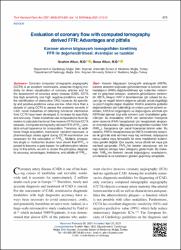Evaluation of coronary flow with computed tomography derived FFR: Advantages and pitfalls
Citation
İbrahim Altun, İlknur Altun. Evaluation of coronary flow with computed tomography derived FFR: Advantages and pitfalls. Turk Kardiyol Dern Ars. 2021; 49(8): 675-681Abstract
Coronary computed tomographic angiography (CCTA) is an excellent noninvasive, anatomic imaging modality for direct visualization of coronary arteries and for the assessment of coronary artery disease (CAD). CCTA has high sensitivity and high negative-predictive value for the identification of obstructive CAD; however, its specificity and positive-predictive value are low. After more than a decade of using CCTA to assess the anatomic severity of CAD, novel modalities of obtaining functional information from CCTA have been developed to increase its specificity and accuracy. These modalities use computational fluid dynamics to calculate fractional flow reserve (FFR) from CCTA datasets. Computed tomography-derived FFR (FFRCT) predicts virtual hyperemia for computation. Therefore, no additional image acquisition, medication, radiation exposure, or pharmacologic stress agent during CCTA examination are necessary for the calculation of FFRCT. Multiple, prospective single or multicenter studies have shown that FFRCT is poised to become a gate-keeper for catheterization laboratory. In this article, we aim to review the principles, diagnostic accuracy, advantages, limitations, and pitfalls of FFRCT.
Source
TURK KARDIYOLOJI DERNEGI ARSIVI-ARCHIVES OF THE TURKISH SOCIETY OF CARDIOLOGYVolume
49Issue
8URI
https://archivestsc.com/jvi.aspx?un=TKDA-99672&volume=49&issue=8https://hdl.handle.net/20.500.12809/9725


















